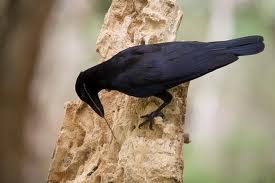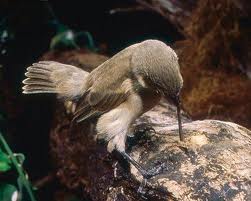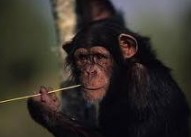Humans are especially good at solving problems using two tricks: language and tools. The manufacture and use of tools was once believed to be uniquely human, but we now know that we share this ability with some animal species, although it seems rare. The complexity of tool use is often seen as an indication of a species' intelligence.
人类尤其擅长运用两项技能来解决问题:语言和工具。制造和使用工具曾一度被认为是人类所特有的本领,但现在我们了解到,某些种类的动物也会制造和使用工具——尽管这样的动物似乎比较少见。动物所使工具的复杂程度常被看作是这个物种智力水平的反映。
Crows  There once was a story about a clever crow which lived in a laboratory. The crow was fed dried mash1), which needed to be moistened before the crow could eat it. However, the keepers occasionally forgot to do so. The crow found a solution to his keepers' absent-mindedness: he used a cup to get water to moisten the mash himself! The cup had been given to the crow as a toy but he used it to collect water from a trough2) on the other side of the room.
There once was a story about a clever crow which lived in a laboratory. The crow was fed dried mash1), which needed to be moistened before the crow could eat it. However, the keepers occasionally forgot to do so. The crow found a solution to his keepers' absent-mindedness: he used a cup to get water to moisten the mash himself! The cup had been given to the crow as a toy but he used it to collect water from a trough2) on the other side of the room.
Egyptian vultures3)
Hungry Egyptian vultures use ingenuity4) in obtaining their food. Since the shells of ostrich5) eggs are too hard to break open by simply pecking6) at them, the vultures use rocks to assist them. The vultures will search as far as 50 yards from the eggs in order to find a proper smashing7) tool.
Vultures originally threw the eggs to break them open. They then evolved to throwing rocks at the eggs. The use of rocks to break the eggs open probably began when a vulture accidentally hit an egg with a rock. Vultures' aim in stone-throwing is poor, hitting the target with only 40~60% of their throws. Despite their imperfect aim, the vultures persist until they succeed in cracking the egg.
Sea otters8)
When feeding, sea otters can often be seen floating on their backs. They dive to the bottom of the ocean and pick up a mollusk9) and a rock. Back at the surface, they then float on their backs placing the rock on their abdomens10). The otters then repeatedly hit the mollusk against the rock in order to break open the hard shell and gain access to the meat inside. Some otters keep the same stone throughout their entire lives, placing it inside their armpit11) for later use.
Octopuses12)
Indonesian octopuses use coconuts as protection from predators13). They carry the shells along with them—squatting14) their bodies inside, with their legs hanging over so they can walk along the ocean floor. When they get to a spot that looks like a nice place to camp, they cover themselves with the shells. They'd even pull the two halves together to create a ball that they can sit more safely inside.
乌鸦
有一个故事讲的是一只养在实验室里的聪明的乌鸦。这只乌鸦每天以干麦麸为食,干硬的麦麸只有用水浸湿后才能吃得下。然而实验室管理员偶尔会忘记这一点。针对管理员的疏忽大意,乌鸦找到了一个解决办法:它用一只杯子取水,自己把麦麸弄湿!这只杯子本来是丢给它当玩具的,结果却被它用作工具,从房间另一端的水槽中取水!
埃及秃鹰
饥饿的埃及秃鹰为了获得食物可谓费尽了心思。驼鸟蛋的蛋壳很硬,光用嘴啄根本啄不开,于是秃鹰便找来石头给自己帮忙。为了寻找一件合适的砸蛋工具,秃鹰甚至会跑到50码开外的地方去。
最初的时候,秃鹰采取用力掷鸟蛋的方式将其磕开,后来则演化为衔起石头往鸟蛋上砸。用石头砸蛋的做法很可能起源自某只秃鹰无意间用石头击中了鸟蛋。秃鹰的投石命中率很低,仅有40~60%的成功率。尽管如此,它们仍会坚持不懈,直到将鸟蛋砸开为止。
海獭
海獭吃东西的时候,常常是仰面朝天地漂浮在水上。它们潜到海底抓一只软体动物,再拣一块石头,然后回到水面上仰浮着,把石头放在肚子上。为了砸开软体动物的硬壳吃到里面的肉,海獭拿着它一个劲儿地朝石头上砸。有的海獭一辈子都用同一块石头,它们将石头放在腋窝里以备后用。
章鱼
印度尼西亚的章鱼用椰子壳抵御捕食者。它们走到哪都随身带着椰子壳——身体蜷伏在里面,爪子伸出来,以便在海底爬行。如果它们找到了一个可以安营扎寨的好地方,就用椰子壳将自己扣起来。它们甚至会将两个半球形的椰子壳拼在一起,形成一个球状空间,以便让自己在里面待得更安全。
Woodpecker finches15)  The woodpecker finch, found in the Galapagos Islands, isn't actually a woodpecker. True woodpeckers peck to loosen bark on a tree, then use their long tongues to search for grubs16). Woodpecker finches' tongues are too short for that. So they use a cactus17) spine18) to pull grubs from the bark. The finches then drop the spine and hold it under their feet while eating the grub. The cactus spine is carried from branch to branch for reuse.
The woodpecker finch, found in the Galapagos Islands, isn't actually a woodpecker. True woodpeckers peck to loosen bark on a tree, then use their long tongues to search for grubs16). Woodpecker finches' tongues are too short for that. So they use a cactus17) spine18) to pull grubs from the bark. The finches then drop the spine and hold it under their feet while eating the grub. The cactus spine is carried from branch to branch for reuse.
A researcher was fortunate enough to observe a young woodpecker finch's acquisition19) of the skill of using the cactus spine. The finch began by attempting to obtain grubs from a tree branch simply by using its beak20). When that system frequently failed, the finch snapped off a part of a forked twig in order to make a tool. Scientists also observed woodpecker finches shortening long cactus spines in order to form more manageable tools.
Green herons21)
The green heron drops a small object onto the surface of the water. Fish swim to the surface, hoping that the object might be their food. The heron then seizes the fish and eats it.
The practice of bait22) fishing is rare among green herons. This fact indicates that it is not an innate behavior. The roots of using objects to attract fish are unclear. One theory suggests that herons are imitating human behavior when they use bait for fishing. Another possibility is that herons learn to use bait for fishing through experience, i.e. the heron accidentally drops an object in the water and sees the object's attraction to fish.
形树雀
加拉帕哥斯群岛的 形树雀其实并不属于啄木鸟。真正的啄木鸟用嘴将树皮啄松之后,用长长的舌头钩食里面的幼虫。而形树雀的舌头太短了,根本够不到,于是它们便借用仙人掌的刺将幼虫从树皮中拨出来,美餐之时则将刺放下来用爪子踩住。仙人掌的刺就这样被它们从一个枝头带到另一个枝头,循环利用。
一位研究者有幸观察到了一只幼小的形树雀是如何获得这种本领的。起初,它试图只凭一张嘴就将幼虫从树枝中钩出来。无奈这种方法频频失败,小树雀只得咬断一截叉状嫩枝,将其制成工具。科学家还观察到
形树雀将仙人掌的刺弄短,以便用起来更加顺手。
绿鹭
绿鹭在水面上投下一个小东西。鱼儿游到水面,希望绿鹭投下的东西会是它们的美食。没想却被绿鹭抓住吞下了肚。
用鱼饵“钓”鱼的做法在绿鹭中比较少见,这说明它们并不是天生就有这种本领的。没人清楚绿鹭是怎么想起来用小东西来引诱鱼儿的。有理论表明,绿鹭用鱼饵“钓”鱼的做法其实是在模仿人类。还有一种可能是,绿鹭是在实践中逐渐悟得这个窍门的,比如,绿鹭某次无意间将小东西丢到了水里,结果竟发现鱼儿都被吸引了过来。
Chimps23)  While manipulating poles in their play, chimps learned to use the poles to escape from their enclosure. Researchers observed that chimps were very selective about the poles which they used as climbing tools. They discarded old pieces of wood which might break, ones which were too long or too short for carrying. Chimps show sophisticated24) tool use in that they can modify25) objects to form tools. For example, they have been observed joining two sticks together to make a longer tool for reaching high places.
While manipulating poles in their play, chimps learned to use the poles to escape from their enclosure. Researchers observed that chimps were very selective about the poles which they used as climbing tools. They discarded old pieces of wood which might break, ones which were too long or too short for carrying. Chimps show sophisticated24) tool use in that they can modify25) objects to form tools. For example, they have been observed joining two sticks together to make a longer tool for reaching high places.
In Tanzania, chimps construct tools from grass and twigs which they use to extract ants from their holes. Wild chimps have also been observed using sticks to withdraw honey from beehives, dig up edible roots, and as levers26) to open boxes of bananas left by scientists. Leaves are also used as tools by chimps for collecting water and for wiping mud, blood, and sticky fruit from their bodies.
Monkeys
In an experiment, monkeys demonstrated similar to those of the chimps. These monkeys were faced with the challenge of extracting yogurt from narrow plastic tubes. The tubes were too narrow to probe with their fingers and were fixed to the table to prevent the monkeys from pouring out the contents. The monkeys cleverly made spoons from pieces of wood which were available in the experiment room.
黑猩猩
在摆弄木棍玩耍的过程中,黑猩猩学会了如何利用木棍来帮自己逃出围困。研究者还发现,黑猩猩在选择木棍作为攀援工具时相当挑剔。朽木容易折断的不要,过长过短不便携带的也不要。黑猩猩对工具的运用可谓相当娴熟:它们甚至可以把物体改造成工具。比如,有人看到它们将两截木棍连在一起做成更长的工具,以便够到高处的东西。
在坦桑尼亚,黑猩猩用草叶和嫩枝作工具,将蚂蚁从洞穴中引出来。人们还观察到木棍在野生黑猩猩手中的多种用途:伸到蜂巢里蘸食蜂蜜,从土里刨寻可食根茎,或是用作撬棒撬开科学家留下的成箱的香蕉。黑猩猩还会用树叶采水,擦拭身上的泥巴、血渍或是黏稠的水果浆汁。
猴子
在一项试验中,猴子表现得和前面提到的黑猩猩有些相似。摆在它们面前的难题是如何将酸奶从细长的塑料管中取出来。塑料管太细了,猴子没法将手指伸进去。为了防止它们直接倒出酸奶,塑料管还被固定在了桌面上。没想到,聪明的猴子竟将实验室里的几块木片做成了勺子!
1. mash [mAF] n. 麦麸(由谷糠和营养物质调成的混合物,用以饲养牲畜和家禽)
2. trough [trC:f] n. 饲料槽;饮水槽
3. vulture [5vQltFE(r)] n. 【鸟】兀鹫
4. ingenuity [7IndVI5nju:EtI] n. 心灵手巧;善于创造发明
5. ostrich [5CstrItF] n. 【鸟】鸵鸟
6. peck [pek] vi. 啄
7. smash [smAF] vt. 打碎,打破
8. sea otter: 海獭;otter [5CtE(r)] n.【动】水獭
9. mollusk [5mClEsk] n. <美> = mollusc【动】软体动物
10. abdomen [5AbdEmEn, Ab5dEumEn] n. 腹(部)
11. armpit [5B:mpIt] n. 腋(窝),夹肢窝
12. octopus [5CktEpEs] n. ([复] octopuses或octopi)【动】章鱼属软体动物;章鱼
13. predator [5predEtE(r)] n. 捕食者
14. squat [skwCt] vt. 使蹲,使蹲坐
15. woodpecker finch: 形树雀(“ ”即啄木鸟的意思);woodpecker [5wud7pekE(r)] n.【鸟】啄木鸟;finch [fIntF] n. 雀科鸣鸟(如燕雀、金翅雀等)
16. grub [^rQb] n.【昆】(昆虫的)幼虫
17. cactus [5kAktEs] n.【植】仙人掌;仙人掌属植物
18. spine [spaIn] n.【植】刺
19. acquisition [7AkwI5zIFEn] n. 取得,获得
20. beak [bi:k] n. (鹰、鹦鹉等的)喙
21. green heron: 【鸟】绿鹭;heron [5herEn] n.【鸟】鹭
22. bait [beIt] n. (诱捕鱼、兽等的)饵
23. chimp [tFImp] n. <口> = chimpanzee[7tFImpEn5zi:] n.【动】黑猩猩
24. sophisticated [sE5fIstIkeItId] adj. 老练的,富有经验的;精通的
25. modify [5mCdIfaI] vt. 更改;改变;改造
26. lever [5li:vE(r), 5levE(r)] n. 撬棒,杠杆
